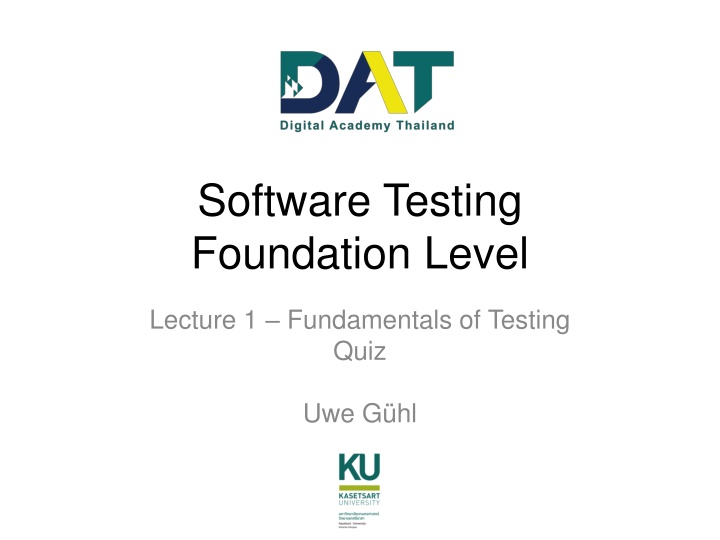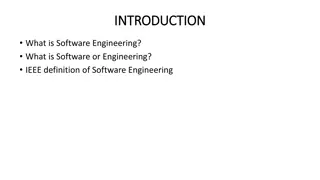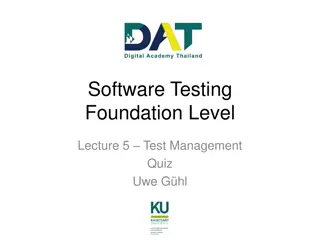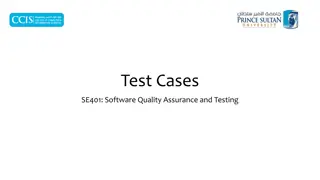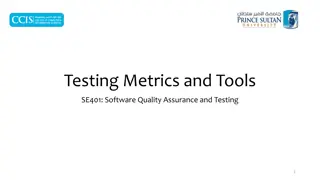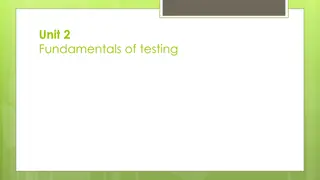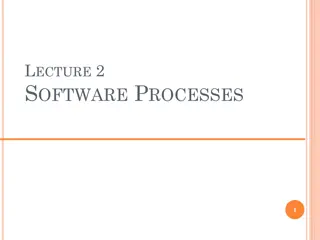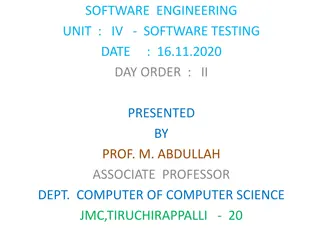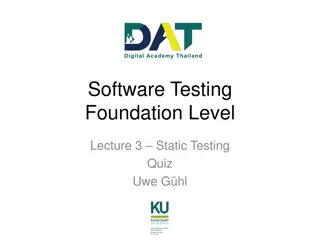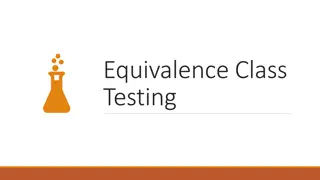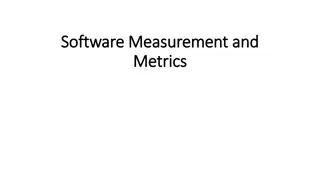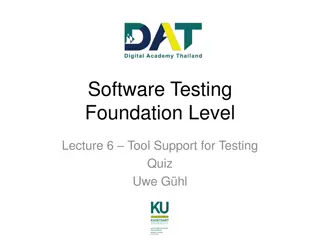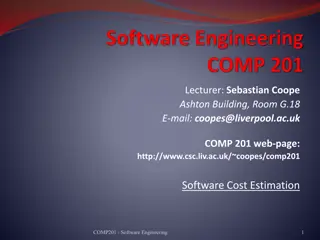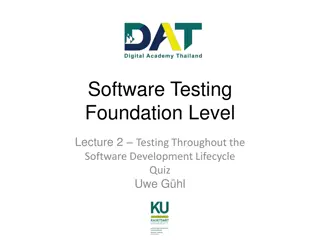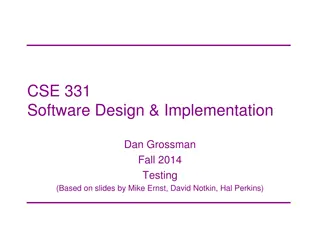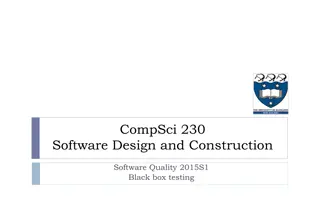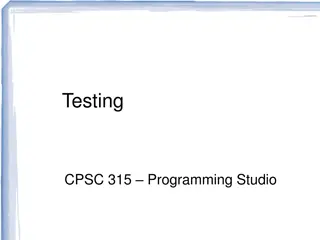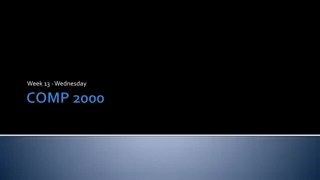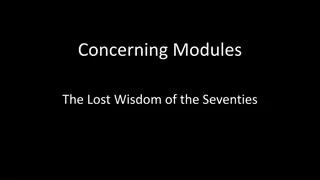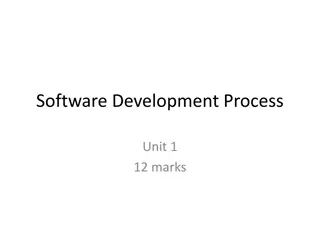Fundamentals of Software Testing: Quiz on Testing Principles
This quiz focuses on fundamental concepts in software testing, covering topics such as test conditions, testing objectives, differences between testing and debugging, and common failure scenarios. Questions are structured to assess understanding of key principles and objectives in software testing.
Download Presentation

Please find below an Image/Link to download the presentation.
The content on the website is provided AS IS for your information and personal use only. It may not be sold, licensed, or shared on other websites without obtaining consent from the author.If you encounter any issues during the download, it is possible that the publisher has removed the file from their server.
You are allowed to download the files provided on this website for personal or commercial use, subject to the condition that they are used lawfully. All files are the property of their respective owners.
The content on the website is provided AS IS for your information and personal use only. It may not be sold, licensed, or shared on other websites without obtaining consent from the author.
E N D
Presentation Transcript
Software Testing Foundation Level Lecture 1 Fundamentals of Testing Quiz Uwe G hl
Disclaimer All the questions collected in this presentation are based on sample exams provided by istqb.org, available at https://www.istqb.org/downloads/ FL 2018 Sample Questions Exam A FL 2018 Sample Questions Exam B FL 2018 Sample Questions Exam C Software Testing Foundation Level Fundamentals of Testing Quiz Uwe G hl, 2020 01 - 2
1. Fundamentals of Testing FL-1.x A Which one of the following answers describes a test condition? a) An attribute of a component or system specified or implied by requirements documentation. b) An aspect of the test basis that is relevant to achieve specific test objectives. c) The degree to which a software product provides functions which meet stated and implied needs when the software is used under specified conditions. d) The percentage of all single condition outcomes that independently affect a decision outcome that have been exercised by a test suite. Software Testing Foundation Level Fundamentals of Testing Quiz Uwe G hl, 2020 01 - 3
1. Fundamentals of Testing FL-1.1.1 A Which of the following statements is a valid objective for testing? a) The test should start as late as possible so that development had enough time to create a good product. b) To find as many failures as possible so that defects can be identified and corrected. c) To prove that all possible defects are identified. d) To prove that any remaining defects will not cause any failures. Software Testing Foundation Level Fundamentals of Testing Quiz Uwe G hl, 2020 01 - 4
1. Fundamentals of Testing FL-1.1.2 A Which of the following statements correctly describes the difference between testing and debugging? a) Testing identifies the source of defects; debugging analyzes the defects and proposes prevention activities. b) Dynamic testing shows failures caused by defects; debugging finds, analyzes, and removes the causes of failures in the software. c) Testing removes defects; debugging identifies the causes of failures. d) Dynamic testing prevents the causes of failures; debugging removes the failures. Software Testing Foundation Level Fundamentals of Testing Quiz Uwe G hl, 2020 01 - 5
1. Fundamentals of Testing FL-1.2.3 A Which one of the statements below describes the most common situation for a failure discovered during testing or in production? a) The product crashed when the user selected an option in a dialog box. b) The wrong version of a compiled source code file was included in the build. c) The computation algorithm used the wrong input variables. d) The developer misinterpreted the requirement for the algorithm. Software Testing Foundation Level Fundamentals of Testing Quiz Uwe G hl, 2020 01 - 6
1. Fundamentals of Testing FL-1.3.1 A Mr. Test has been testing software applications on mobile devices for a period of 5 years. He has a wealth of experience in testing mobile applications and achieves better results in a shorter time than others. Over several months Mr. Test did not modify the existing automated test cases and did not create any new test cases. This leads to fewer and fewer defects being found by executing the tests. What principle of testing did Mr. Test not observe? a) Testing depends on the environment. b) Exhaustive testing is not possible. c) Repeating of tests will not find new defects. d) Defects cluster together. Software Testing Foundation Level Fundamentals of Testing Quiz Uwe G hl, 2020 01 - 7
1. Fundamentals of Testing FL-1.2.2 A In what way can testing be part of Quality Assurance? a) It ensures that requirements are detailed enough. b) It contributes to the achievement of quality in a variety of ways. c) It ensures that standards in the organization are followed. d) It measures the quality of software in terms of number of executed test cases. Software Testing Foundation Level Fundamentals of Testing Quiz Uwe G hl, 2020 01 - 8
1. Fundamentals of Testing FL-1.4.2 A Which of the following activities is part of the main activity "test analysis" in the test process? a) Identifying any required infrastructure and tools. b) Creating test suites from test scripts. c) Analyzing lessons learned for process improvement. d) Evaluating the test basis for testability. Software Testing Foundation Level Fundamentals of Testing Quiz Uwe G hl, 2020 01 - 9
1. Fundamentals of Testing FL-1.4.3 A Match the following test work products (1-4) with the right description (A-D). 1. Test suite. 2. Test case. 3. Test script. 4. Test charter. A. A group of test scripts with a sequence of instructions. B. A set of instructions for the execution of a test. C. Contains expected results. D. An instruction of test goals and possible test ideas on how to test. a) 1A, 2C, 3B, 4D. b) 1D, 2B, 3A, 4C. c) 1A, 2C, 3D, 4B. d) 1D, 2C, 3B, 4A. Software Testing Foundation Level Fundamentals of Testing Quiz Uwe G hl, 2020 01 - 10
1. Fundamentals of Testing FL-Keywords B Which of the following provides the BEST description of a test case? a) A document specifying a sequence of actions for the execution of a test. Also known as test script or manual test script. b) A set of input values and expected results, with execution preconditions and execution postconditions, developed for a particular test condition. c) An attribute of a system specified by requirements documentation (for example reliability, usability or design constraints) that is executed in a test. d) An item or event of a system that could be verified by one or more test conditions, e.g., a function, transaction, feature, quality attribute, or structural element. Software Testing Foundation Level Fundamentals of Testing Quiz Uwe G hl, 2020 01 - 11
1. Fundamentals of Testing FL-1.1.1 B Which of the following is a major objective of testing? a) To prevent defects. b) To validate the project plan works as required. c) To gain confidence in the development team. d) To make release decisions for the system under test. Software Testing Foundation Level Fundamentals of Testing Quiz Uwe G hl, 2020 01 - 12
1. Fundamentals of Testing FL-1.2.3 B Which of the following is an example of a failure in a car cruise control system? a) The developer of the system forgot to rename variables after a cut-and-paste operation. b) Unnecessary code that sounds an alarm when reversing was included in the system. c) The system stops maintaining a set speed when the radio volume is increased or decreased. d) The design specification for the system wrongly states speeds in km/h. Software Testing Foundation Level Fundamentals of Testing Quiz Uwe G hl, 2020 01 - 13
1. Fundamentals of Testing FL-1.2.4 B Which of the following is a defect rather than a root cause in a fitness tracker? a) Because he was unfamiliar with the domain of fitness training, the author of the requirements wrongly assumed that users wanted heartbeat in beats per hour. b) The tester of the smartphone interface had not been trained in state transition testing, so missed a major defect. c) An incorrect configuration variable implemented for the GPS function could cause location problems during daylight saving times. d) Because she had never worked on wearable devices before, the designer of the user interface misunderstood the effects of reflected sunlight. Software Testing Foundation Level Fundamentals of Testing Quiz Uwe G hl, 2020 01 - 14
1. Fundamentals of Testing FL-1.3.1 B As a result of risk analysis, more testing is being directed to those areas of the system under test where initial testing found more defects than average. Which of the following testing principles is being applied? a) Beware of the pesticide paradox. b) Testing is context dependent. c) Absence-of-errors is a fallacy. d) Defects cluster together. Software Testing Foundation Level Fundamentals of Testing Quiz Uwe G hl, 2020 01 - 15
1. Fundamentals of Testing FL-1.4.2 B Given the following test activities and tasks: A. Test design B. Test implementation C. Test execution D. Test completion 1. Entering change requests for open defect reports 2. Identifying test data to support the test cases 3. Prioritizing test procedures and creating test data 4. Analyzing discrepancies to determine their cause Which of the following BEST matches the activities with the tasks? a) A-2, B-3, C-4, D-1 b) A-2, B-1, C-3, D-4 c) A-3, B-2, C-4, D-1 d) A-3, B-2, C-1, D-4 Software Testing Foundation Level Fundamentals of Testing Quiz Uwe G hl, 2020 01 - 16
1. Fundamentals of Testing FL-1.4.4 B Which of the following BEST describes how value is added by maintaining traceability between the test basis and test artifacts? a) Maintenance testing can be fully automated based on changes to the initial requirements. b) It is possible to determine if a new test case has increased coverage of the requirements. c) Test managers can identify which testers found the highest severity defects. d) Areas that may be impacted by side-effects of a change can be targeted by confirmation testing. Software Testing Foundation Level Fundamentals of Testing Quiz Uwe G hl, 2020 01 - 17
1. Fundamentals of Testing FL-1.5.2 B Which of the following qualities is MORE likely to be found in a tester s mindset rather than in a developer s? a) Experience on which to base their efforts. b) Ability to see what might go wrong. c) Good communication with team members. d) Attention to detail. Software Testing Foundation Level Fundamentals of Testing Quiz Uwe G hl, 2020 01 - 18
1. Fundamentals of Testing Keywords C What is quality? a) Part of quality management focused on providing confidence that quality requirements will be fulfilled. b) The degree to which a component, system or process meets specified requirements and/or user/customer needs and expectations. c) The degree to which a component or system protects information and data so that persons or other components or systems have the degree of access appropriate to their types and levels of authorization. d) The total costs incurred on quality activities and issues and often split into prevention costs, appraisal costs, internal failure costs and external failure costs. Software Testing Foundation Level Fundamentals of Testing Quiz Uwe G hl, 2020 01 - 19
1. Fundamentals of Testing FL-1.1.1 C Which of the following is a typical test objective? a) Preventing defects b) Repairing defects c) Comparing actual results to expected results d) Analyzing the cause of failure Software Testing Foundation Level Fundamentals of Testing Quiz Uwe G hl, 2020 01 - 20
1. Fundamentals of Testing FL-1.2.4 C A phone ringing in an adjacent cubicle momentarily distracts a programmer, causing the programmer to improperly program the logic that checks the upper boundary of an input variable. Later, during system testing, a tester notices that this input field accepts invalid input values. The improperly coded logic for the upper boundary check is: a) The root cause b) The failure c) The error d) The defect Software Testing Foundation Level Fundamentals of Testing Quiz Uwe G hl, 2020 01 - 21
1. Fundamentals of Testing FL-1.3.1 C A product owner says that your role as a tester on an Agile team is to catch all the bugs before the end of each iteration. Which of the following is a testing principle that could be used to respond to this statement? a) Defect clustering b) Testing shows the presence of defects c) Absence of error fallacy d) Root cause analysis Software Testing Foundation Level Fundamentals of Testing Quiz Uwe G hl, 2020 01 - 22
1. Fundamentals of Testing FL-1.5.2 C Programmers often write and execute unit tests against code which they have written. During this self-testing activity, which of the following is a tester mindset that programmers should adopt to perform this unit testing effectively? a) Good communication skills b) Code coverage c) Evaluating code defects d) Attention to detail Software Testing Foundation Level Fundamentals of Testing Quiz Uwe G hl, 2020 01 - 23
1. Fundamentals of Testing FL-1.4.4 C Consider the following testing activities: 1. Selecting regression tests 2. Evaluating completeness of test execution 3. Identifying which user stories have open defect reports 4. Evaluating whether the number of tests for each requirement is consistent with the level of product risk Consider the following ways traceability can help testing: A. Improve understandability of test status reports to include status of test basis items B. Make testing auditable C. Provide information to assess process quality D. Analyze the impact of changes Which of the following best matches the testing activity with how traceability can assist that activity? a) 1D, 2B, 3C, 4A b) 1B, 2D, 3A, 4C c) 1D, 2C, 3A, 4B d) 1D, 2B, 3A, 4C Software Testing Foundation Level Fundamentals of Testing Quiz Uwe G hl, 2020 01 - 24
1. Fundamentals of Testing FL-1.2.1 C A tester participated in a discussion about proposed database structure. The tester identified a potential performance problem related to certain common user searches. This possible problem was explained to the development team. Which of the following is a testing contribution to success that BEST matches this situation? a) Enabling required tests to be identified at an early stage b) Ensuring processes are carried out properly c) Reducing the risk of fundamental design defects d) Reducing the risk of untestable functionality Software Testing Foundation Level Fundamentals of Testing Quiz Uwe G hl, 2020 01 - 25
1. Fundamentals of Testing FL-1.4.2 C Which of the following is an example of a task that can be carried out as part of the test process? a) Analyzing a defect b) Designing test data c) Assigning a version to a test item d) Writing a user story Software Testing Foundation Level Fundamentals of Testing Quiz Uwe G hl, 2020 01 - 26
